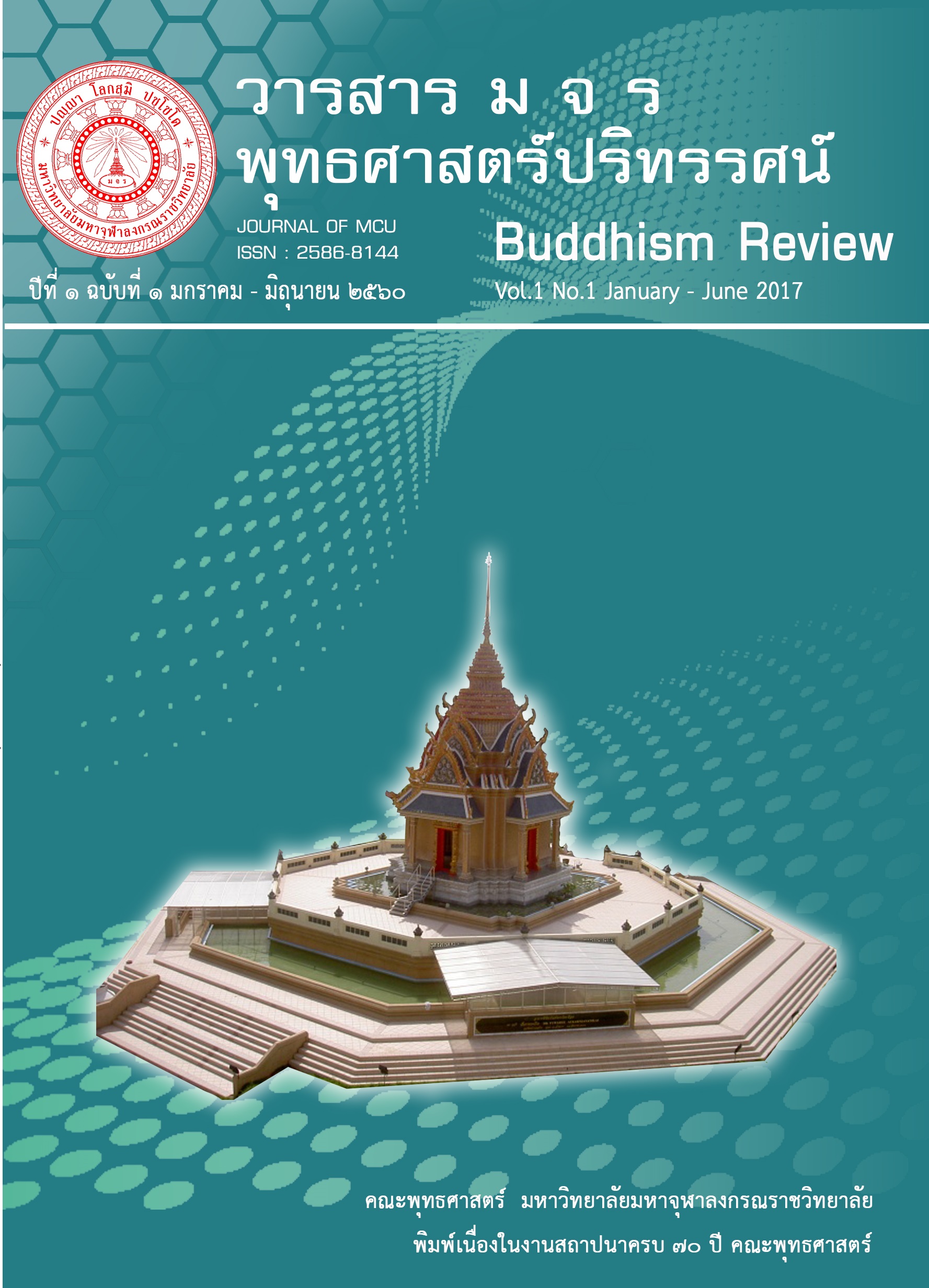ประวัติและพัฒนาการพระพุทธศาสนาในจังหวัดพิษณุโลกสมัยสุโขทัย : กรณีศึกษาพุทธศิลป์แบบพระพุทธชินราช
Main Article Content
บทคัดย่อ
งานวิจัยนี้ มีวัตถุประสงค์ ๒ ประการ คือ (๑) เพื่อศึกษาประวัติและพัฒนาการของพระพุทธศาสนาในจังหวัดพิษณุโลกสมัยสุโขทัย (๒) เพื่อศึกษาพุทธศิลป์แบบพระพุทธชินราชที่เป็นมรดกตกทอดมาถึงสมัยปัจจุบันวิธีการศึกษาเป็นการวิจัยเอกสาร โดยค้นคว้าจากหนังสือ และเอกสารเกี่ยวกับ ปฏิมากรรมพุทธศิลป์สมัยต่างๆ ในประเทศไทย
ผลการศึกษาพบว่า พิษณุโลกเป็นเมืองเก่าแก่สืบย้อนไปถึงสมัยพ่อขุนบางกลางท่าว ซึ่งต่อมาคือพ่อขุนศรีอินทราทิตย์ ผู้สถาปนาวงศ์พระร่วงแห่งสุโขทัย ในพุทธศตวรรษที่ ๑๘ เมื่อสุโขทัยเป็นราชธานี พิษณุโลกก็เป็นเมืองลูกหลวง ประวัติศาสตร์พระพุทธศาสนาและการสร้างพระพุทธรูปจึงร่วมสมัยกับสุโขทัย พระพุทธชินราช เป็นพระพุทธรูปองค์เดียวที่มีพุทธลักษณะสวยงามที่สุด สร้างสมัยกรุงสุโขทัย ลักษณะพระพักตร์เป็นแบบเชียงแสนผสมกับสุโขทัย โดยพระพุทธรูปสมัยเชียงแสน ได้รับอิทธิพลของศิลปะสมัยคุปตะและปาละของอินเดีย พระพุทธรูปในสมัยสุโขทัยยุคต้นและในช่วงยุคกลาง ต่อมาสกุลช่างแบบอย่างพระพุทธชินราชได้เจริญขึ้นในเมืองพิษณุโลก(พ.ศ. ๑๘๐๐ – ๑๙๘๑) สร้างในสมัยพระมหาธรรมราชาลิไท (พ.ศ. ๑๘๙๐ - ๑๙๑๖) หลังจากนั้นทาให้ศิลปะของสมัยสุโขทัยเริ่มเสื่อมลง ดังนั้น จึงพบว่าพระพุทธชินราชมีความงดงามตามแนวพุทธศิลป์สุโขทัยยุคต้น พระพุทธชินราชเป็นศิลปะสมัยสุโขทัย และมีลักษณะฝีมือช่างอันประณีตเป็นเอกลักษณ์ของตนเอง จึงแยกออกเป็นหมวดพระพุทธชินราชมีพระพุทธรูปสาคัญสร้างยุคเดียวกันอีกหลายองค์ เช่นพระพุทธชินสีห์ พระศรีศาสดา พระสิทธารถ พระเสฏฐตมมุนี พระพุทธชินราชวโรวาทธรรมจักร และพระพุทธชินสีห์มุนีนาถ เป็นต้น พุทธศิลป์แบบพระพุทธชินราชได้มีการสร้างจาลองสืบต่อกันเรื่อยมาถึงปัจจุบัน เช่น วัดเบญจมบพิตรดุสิตวนาราม วัดนวลนรดิศ และวัดไทยพุทธคยา เป็นต้น ตลอดจนพระบูชาและพระเครื่องขนาดต่างๆ ในปัจจุบัน พุทธศิลป์ขององค์พระพุทธชินราชสามารถเป็นสื่อที่สร้างความศรัทธาให้เกิดขึ้นกับผู้ที่ได้มานมัสการได้ เกิดปีติเมื่อได้เห็นความงดงาม เห็นความสงบจากองค์พระพุทธชินราช ก็เกิดพลังในการทาความดี ทางกาย ทางวาจา และทางใจ มีหลักพระธรรมคาสั่งสอนที่ดีงามเป็นเครื่องดาเนินชีวิตต่อไปเพื่อระงับทุกข์ได้ในปัจจุบัน
Article Details
- บทความที่ได้รับการตีพิมพ์เป็นลิขสิทธิ์ของวารสาร มจร พุทธศาสตร์ปริทรรศน์
- ข้อความใดๆ ที่ปรากฎในบทความที่ได้รับการตีพิมพ์ในวารสาร ถือเป็นความรับผิดชอบของผู้เขียนบทความ และข้อคิดเห็นนั้นไม่ถือว่าเป็นทัศนะและความรับผิดชอบของกองบรรณาธิการวารสาร มจร พุทธศาสตร์ปริทรรศน์
เอกสารอ้างอิง
กรมศิลปากร. "ศิลาจารึกหลักที่ ๒" ประชุมศิลาจารึกภาคที่ ๑. พิมพ์ครั้งที่ ๓. พระนคร :ท่าพระจันทร์, ๒๕๐๐.
กรมศิลปากร. "ศิลาจารึกหลักที่ ๘". ประชุมศิลาจารึกภาคที่ ๑. พิมพ์ครั้งที่ ๓. พระนคร : ท่าพระจันทร์, ๒๕๐๐.
รองศาสตราจารย์เสนอ นิลเดช. สองแควเมื่อวานพิษณุโลกวันนี้. กรุงเทพมหานคร : โรงพิมพ์อักษรสัมพันธ์, ๒๕๓๒.
สานักงานประชาสัมพันธ์จังหวัดพิษณุโลก. พ่อขุนศรีอินทราทิตย์ พระปฐมบรมกษัตริย์ ผู้สร้างชาติไทย.บรรณาธิการโดย ขวัญทอง สอนศิริ. พิษณุโลก : โรงพิมพ์รัตนสุวรรณการพิมพ์ ๓, ๒๕๕๓.
ศาสตราจารย์ ดร.ประเสริฐ ณ นคร. รวมเรื่องประวัติศาสตร์และวัฒนธรรมเมืองพิษณุโลก. พิมพ์เนื่องในงานพระราชทานเพลิงศพ พระราชรัตนรังษี (ทองปลิว โสรโต) อดีตเจ้าอาวาสวัดพระศรีรัตน มหาธาตุวรมหาวิหาร จังหวัดพิษณุโลก. พิษณุโลก : ส.ทรัพย์การพิมพ์, ๒๕๓๔.
.................., "กษัตริย์และอาณาจักรสุโขทัย". สารัตถคดี ประเสริฐ ณ นคร. กรุงเทพมหานคร : พิฆเณศ, ๒๕๒๗.
ศาสตราจารย์ ดร.ศักดิ์ชัย สายสิงห์. พระพุทธรูปในประเทศไทย : รูปแบบ พัฒนาและความเชื่อของคนไทย. กรุงเทพมหานคร : ภาคประวัติศาสตร์ศิลปะ คณะโบราณคดี มหาวิทยาลัยศิลปากร, ๒๕๕๖.
พระมหาจีรวัฒน์ กนฺตวณฺโณ(กันจู). “ประวัติและพัฒนาการพระพุทธศาสนาในจังหวัดพิษณุโลกสมัย สุโขทัย : กรณีศึกษาพุทธศิลป์แบบพระพุทธชินราช”. วิทยานิพนธ์พุทธศาสตรดุษฎีบัณฑิต.บัณฑิตวิทยาลัย : มหาวิทยาลัยมหาจุฬาลงกรณราชวิทยาลัย, ๒๕๕๘.
พระสมุห์วันชัย เกสรธมฺโม (มีมาก). “การศึกษาศรัทธาของประชาชนที่มีต่อพระพุทธชินราชจังหวัดพิษณุโลก ในฐานะสื่อพุทธศิลป์”. วิทยานิพนธ์พุทธศาสตรมหาบัณฑิต,บัณฑิตวิทยาลัย : มหาวิทยาลัยมหาจุฬาลงกรณราชวิทยาลัย, ๒๕๕๐.
แหล่งการเรียนรู้ในจังหวัดพิษณุโลก, ประวัติเมืองพิษณุโลก[ออนไลน์], แหล่งที่มา : https://www.edu.nu.ac.th/resources/history.asp#p4. [เข้าถึงข้อมูล ๑๑ ตุลาคม ๒๕๕๕].


